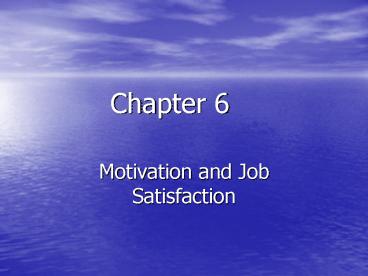Motivation and Job Satisfaction - PowerPoint PPT Presentation
1 / 22
Title:
Motivation and Job Satisfaction
Description:
Herzberg found a relationship between job satisfaction and work performance, ... People who react one of those ways are called equity sensitive. ... – PowerPoint PPT presentation
Number of Views:1834
Avg rating:3.0/5.0
Title: Motivation and Job Satisfaction
1
Chapter 6
- Motivation and Job Satisfaction
2
Motivation
- Motivation in regards to work behavior,
energizes, directs, and sustains good behavior. - It is argued that motivation has lost its
meaning. - Motivation cannot be measured directly.
3
Theories of Motivation
- The first few theories were basic. Taylors
theory was that money was the key to motivation.
The Hawthorne studies believed that happiness was
the key to motivation. - Need theories came next, with three important
ones Maslows hierarchy of needs, Alderfers ERG
theory, and McClellands need to achieve theory.
4
Maslows Hierarchy of Needs
- The first level is the physiological need.
- Next comes the need for safety and security.
- The third level is a social need.
- The fourth level is a need for self esteem.
- The last level is self actualization.
5
Alderfers ERG Theory
- Clayton Alderfer revised Maslows theory.
- Basically simplified it, putting it on three
levels existence, relatedness, and growth. - He concluded that it was too hard to separate
them from lowest to highest, so he said they all
happened simultaneously.
6
McClellands Need to Achieve Theory
- States that work motivation has three needs.
- The need to achieve.
- The need for power.
- The need to affiliate.
7
Problems with need theories
- Maslows and Alderfers theories cannot be tested
very well. - McClellands theory can be tested much easier,
although there are still problems with the
theory. - The need to achieve is tested through a the
Thematic Apperception Test. The scoring on the
exam is still subjective. And you can be taught
how to increase your need to achieve.
8
Job Design Theories
- Job design theories do a better job of arranging
work in ways that will produce the best
performance instead of satisfying deficiencies,
as need theories suggest. - The two main job design theories are Herzbergs
two-factor theory and Hackman and Oldhams job
characteristics theory.
9
Herzbergs Two Factor Theory
- Herzberg found a relationship between job
satisfaction and work performance, which others
had missed. - His basic theory suggests that satisfying
employees motivational needs causes high job
satisfaction and performance. - He also believed that dissatisfaction is caused
by, what he calls hygiene factors, which is the
work environment.
10
- Herzberg added that to achieve high levels of job
satisfaction motivator factors must be present. - Some believe that there is a glaring defect in
his two factor theory. People have suggested that
it is a prime example of the fundamental
attribution error.
11
Hackman and Oldhams Job Characteristics Theory
- Their theory says that certain job elements in
the work environment lead to motivation and
satisfaction. - They created the Job Diagnostic Survey to find
out which parts of jobs influence satisfaction.
The main categories of the test were the core job
characteristics, which were - Skill Variety
12
- Task Identity
- Task Significance
- Autonomy
- Feedback
- They used these factors to calculate the
motivating potential score of a particular job.
13
- They suggested using this formula to motivate
workers by finding ways to increase the value of
the job characteristics. - Through their research they found three
additional factors that can change motivated
behavior growth need strength, knowledge and
skill, and satisfaction with the job. - After job design theories came Cognitive
theories.
14
Cognitive Theories
- Cognitive theories of motivation focus on the
mental activities and perceptions by which people
determine their motivation at work. These
theories suggest that people go through life and
take in experiences and then have expectations
about what will happen in certain situations. - There are three main cognitive theories Adams
Equity theory, Vrooms Expectancy theory, and
Locke and Lathams Goal setting theory.
15
Adams Equity Theory
- Adams equity theory assumes that people want a
fair return compared to other people for the jobs
they do. - It also assumes that people expect certain
outcomes. - When a situation isnt considered fair its
called inequity. - Adams predicts that the inequity will cause one
of six reactions.
16
- Change inputs.
- Change outcomes.
- Leave the situation.
- Change behavior toward comparable workers.
- Distort the situation.
- Change the comparison.
17
- People who react one of those ways are called
equity sensitive. - Benevolents are workers who prefer situations in
which they get fewer outcomes from putting in
greater effort than others do. - Entitleds are people who look for situations
where they get greater outcomes and give less
effort.
18
Vrooms Valence-Instrumentality-Expectancy Theory
- Job outcome
- Valence
- Instrumentality
- Expectancy
- Force
19
Locke and Lathams Goal Setting Theory
- Difficult goals lead to the best job performance.
- Specific goals lead to better performance than no
goals. - High levels of commitment to goals increase
performance. - To influence performance, workers must have
specific feedback about their results. - Goal setting can be harmful.
20
Behavioral Theories
- Behavioral theories of motivation assume that the
positive or negative consequences of behaviors
determine whether a behavior will be repeated or
stopped. - The reinforcement theory assumes that motivated
behavior is caused by the consequences that
follow a behavior. - Reinforcers positive, negative, extrinsic,
intrinsic.
21
Organizational Behavior Modification
- Organizational behavior modification is the
systematic application of learning principles in
order to change behavior in an entire
organization. The focus is on the whole, rather
than the single slice of pie.
22
Job Satisfaction
- Job outcomes
- Job performance
- Turnover
- Absenteeism
- Organizational Commitment
- Job Involvement































